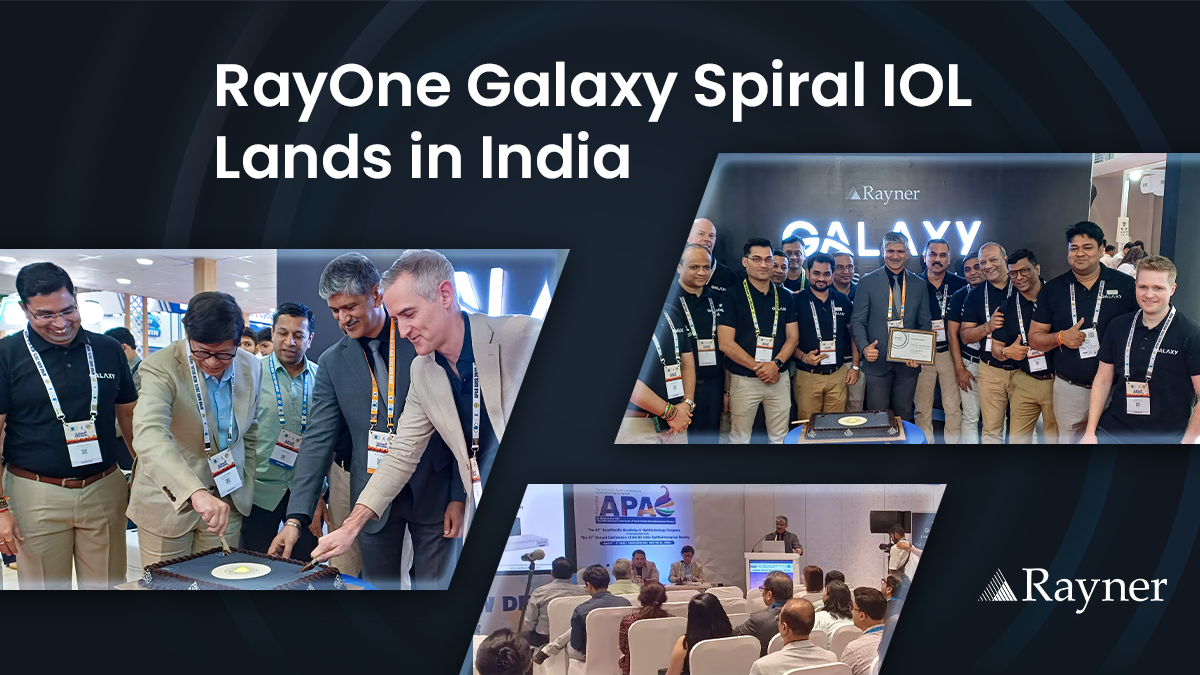One of the year’s breakout cataract intraocular lenses has landed in India at APAO-AIOC 2025 alongside firsthand experiences and preclinical data reveals by Drs. Sri Ganesh and Aanchal Gupta.
Rayner’s RayOne Galaxy IOL’s big year continues with its Indian debut at the 40th Asia-Pacific Academy of Ophthalmology Congress, held in conjunction with the 83rd Annual Conference of the All India Ophthalmological Society (APAO-AIOC 2025).
The India launch of the world’s first spiral IOL, designed with AI, was announced at a cake-cutting ceremony at Rayner’s booth (101-D) at the Yashobhoomi Convention Centre in Delhi.
The ceremonial cake-cutting was followed by a symposium where luminaries from across the region, including Dr. Sri Ganesh (India), Chairman and Managing Director of Nethradhama Hospitals and Dr. Aanchal Gupta (Australia), FRANZCO, FWCRS, spoke on their early experiences with the lens and presented preliminary clinical data.
“I’ve always been an early adopter of technology, and I like to see what new technology brings to my patients and my practice,” said Dr. Ganesh.
“So when I heard about Rayner’s RayOne Galaxy lens, I was very excited, and very happy that I tried it— and I ended up being the first surgeon in India and South Asia to get to implant this lens.”
With its formal debut on the Indian subcontinent at APAO-AIOC 2025, RayOne Galaxy is now available for purchase nationwide. RayOne Galaxy is also immediately available on Rayner’s RayOne Toric platform.
RayOne Galaxy IOL: Features at a glance
RayOne Galaxy is being marketed as the world’s first spiral IOL, offering a full range of vision from distance to near normally reserved for multifocal IOLs—all without the high incidence of dysphotopsia and loss of contrast sensitivity that plague such offerings.
So how does the lens design accomplish all this? We break it all down here.
- Fully refractive spiral optics: The lens’ optical profile includes a first-in-class spiral design, providing smooth, full range-of-vision without the use of diffractive rings or annular zones and the resulting tradeoffs in visual quality.
“RayOne Galaxy has a full range of vision and gives less halo than traditional trifocals, so you have patients who are able to enjoy spectacle-free vision,” said Dr. Ganesh.
“It’s like if you’re going up a spiral staircase and there’s another person opposite you— you’re not at the same level. There are no sharp edges with this lens, unlike a trifocal. It’s got a very smooth blend—it’s more of a refractive power change and this gives you an elongated focus and a full range of vision from distance intermediate and near.”
- Minimized dysphotopsia: Galaxy’s spiral design means minimal dysphotopsias like halos and glare compared to multifocal lenses that utilize diffractive optics to achieve a similar range-of-vision.
“There are no abrupt transitions in the lens surface, and thats why the dysphotopsia is less,” said Dr. Ganesh.
“There’s clear differences between a typical trifocal lens and the Galaxy,” echoed Dr. Gupta. “Of these patients in fact, 31 percent recorded no halos or glare, which is essentially unheard of when you ask that from a trifocal patient.”
- Optimized light transmission: Galaxy’s non-diffractive optic ensures 0% loss of transmitted light for maximal visual clarity and superior contrast sensitivity.
“I was very pleasantly surprised to see the contrast sensitivity results because normally with a lower frequency, spatial frequency they are within the normal range, but as you go to the higher spatial frequency for contrast testing there is a drop below the normal range,” said Dr. Ganesh.
“With this lens, throughout the entire range from low to higher spatial frequencies, it was in the normal contrast range.”
- Hydrophilic material: Rayner’s proprietary Rayacryl polymer offers softness with a low refractive index and low inflammation response.
- Designed with artificial intelligence: The lens design was honed with an artificial intelligence model trained on patient-reported outcomes (PROMs) to maximize postoperative satisfaction.
Clinical data and first experiences with RayOne Galaxy
But how does this litany of cutting-edge, first-in-class features translate to the real world?
World-renowned surgeons Dr. Sri Ganesh and Dr. Aanchal Gupta were on hand in Delhi to present their early clinical experiences with the lens and preclinical data.
To demonstrate the lens’ range of vision, Dr. Ganesh displayed Galaxy’s defocus curve. “You can see on the simulated defocus curve that you get good distance vision, and you have a plateau for intermediate and near. There are no sharp dips,” he said.
Dr. Gupta echoed this assessment in her presentation. “I’m seeing very, very good vision outcomes for distance, intermediate and near with Galaxy,” she said.
Dr. Ganesh then presented his initial results from the post-market, real-world evaluation he performed in his clinic. This followed the global FIE evaluation from top cataract surgeons from across the globe, including Prof. Gerd Auffarth (Germany) and Mr. Allon Barsam (United Kingdom), among others.
The results in Dr. Ganesh’ evaluation were encouraging, with 92% of his patients achieving 20/25 vision.
Postoperative surprises also received high marks from Dr. Ganesh. “The refractive accuracy of this lens is very good, and very predictable,” he said. For refractive astigmatism, all eyes were within 0.5 diopters.
The RayOne Galaxy Toric showed similarly impressive results—residual refraction was less than 0.5 diopter. “This really improves patient satisfaction,” Dr. Ganesh said.
As for contrast sensitivity, RayOne Galaxy stacks up impressively against its trifocal competition. “Even at week one, contrast sensitivity is within the normal band—but how it is different from trifocals is that if you look at higher spatial frequencies, it drops off less than normal,” he said.
“Even at higher spatial frequencies it is well within the normal range, because there is no light loss–and this makes a major difference in the quality of vision and patient satisfaction,”
So what are the prospects for Galaxy given these returns? Dr. Ganesh summed up his first impressions of RayOne Galaxy. “[The modern cataract patient in India] is quite young. They want vision for distance, intermediate and near and want independence from glasses” he said.
“The Galaxy opens up a whole new dimension because there are lot of patients who want good night vision also and who want to drive at night and we can now cater to these patients.”
Impact on the Indian market
The Indian eye care market is an ideal landing spot for premium IOLs like RayOne Galaxy and the full range of vision it offers.
According to India’s Ministry of Statistics & Programme Implementation, yearly incomes in the country increased 35.12% (adjusted for 2011-2012 prices) from 2014 to 2023.1
This rise in income has been accompanied by rapidly increasing prospects in cataract surgery.
According to a February 2025 retrospective study2 on the Indian cataract market from 2012-2023, Indian cataract patients are looking for cataract surgery sooner, gaining access to better surgical outcomes, and are willing to pay more for the improvements—-a market primed for the premium range that RayOne Galaxy offers with minimal impact on quality of vision.
How to learn more about RayOne Galaxy
With the debut of Rayner’s RayOne Galaxy and its innovative design in India, one of the world’s most innovative IOLs meets a market ready ripe for the lens’ cutting-edge design and first-in-class results on range and quality of vision tradeoffs.
For more about RayOne Galaxy, stop by Rayner’s APAO-AIOC 2025 booth at 101-D, or get in contact with a Rayner India representative today.
References
- India Ministry of Statistics & Programme Implementation, Press Release. Available at: https://pib.gov.in/PressReleaseIframePage.aspx?PRID=1945144 Accessed on 5 April 2025.
- Gupta S, Ravilla RD, Aravind H, Chandrashekharan S, Ravilla TD. Changing patterns in cataract surgery indications, outcomes, and costs, 2012-2023: a retrospective study at Aravind Eye Hospitals, India. Lancet Reg Health Southeast Asia. 2025;33:100530.
Editor’s Note: This content is intended exclusively for healthcare professionals and eye care practitioners. It is not intended for the general public. Products or therapies discussed may not be registered or approved in all jurisdictions, including Singapore.



